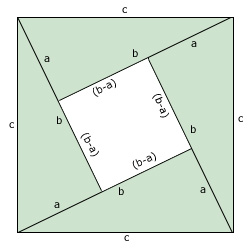When I was young, I read a book where a character, Elmer Dimsdale, sang a song that said that the square of a hypotenuse of a triangle equals the sum of the square of the other two sides — and that there are over a thousand ways to prove it. I have no idea what are the thousand ways to prove the familiar Pythagorean Theorem (a2 + b2 = c2), but here is one that is pretty straightforward.
Consider the following diagram:

If we add the area of the small white rectangle with the area of the four blue triangles, it should equal the area of the outer square. Expressed as an equation it is:
(area of small rectangle) + 4 * (area of blue triangle) = (area of outer rectangle)
The areas of the rectangles and triangles can be substituted with their corresponding formulas:
(b – a)2 + 4 * (0.5ab) = c2
Expanding the equation, we get:
b2 – 2ab + a2 + 2ab = c2
And after canceling some terms and rearranging the others, we get:
a2 + b2 = c2


February 27th, 2007 at 5:28 pm
thiz really helped do my homework also it makes me understand whatam doing. you should do thiz often.